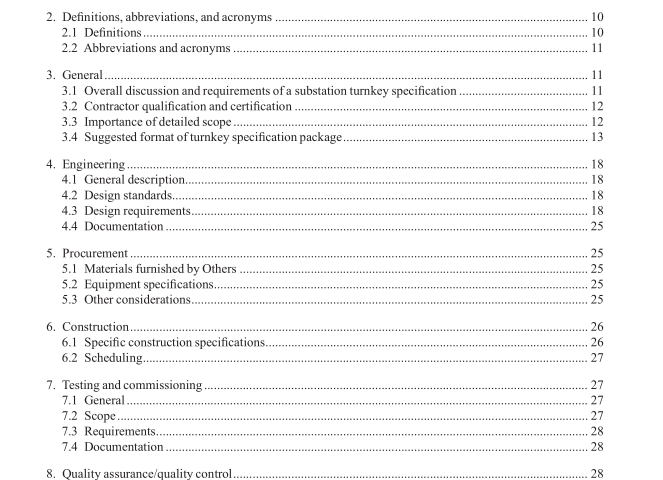IEEE 1267-2019 pdf download.IEEE Guide for Development of Specifications for Turnkey Substation Projects
3. General
3.1 Overall discussion and requirements of a substation turnkey specification
The term turnkey refers to the method of contracting on a given project whereby the contractor assumes total responsibility for the execution of the project from design, procurement of materials and equipment, through construction and commissioning of the project and“turms over the keys”upon completion of the project. This method can apply to new substations or modifications to existing substations. The ultimate result is provision of the project from contractor to purchaser as a fully functional product in turnkey form. The term turnkey is also commonly known as engineer, procure, and construct (EPC) or design-build, but for the purposes of this guide, the terminology turnkey will be used. The turnkey specification generally includes discussion of scope, schedule and commercial items.
The contractor’s scope will typically include, but not necessarily be limited to the following, as determined by the detailed scope definition in the specification:
a) Perlhrm detailed design engineering of the substation, to the design and engineering standards defined by the purchaser.
b) Provide drawings and design documcntation. schedules and coordination ofservices ofsubcontractors if any.
c) Procure materials and equipment to be installed in the substation, not otherwise procured by purchaser or others. Procurement efforts will include specifying, expediting, shipping and transportation, customs clcarancc (where applicable), handling, inspection, witness testing. and sceure storage at the substation site, or some other location determined by the project.
d) Provide construction ofcivil works, erection of steel structures, and equipment installation.
e) Supply necessary labor and project management personnel to construct, test and commission the substation.
I’) Supply safety and security personnel necessary for the project.
g) Supply operations and maintenance training lbr completed project.
h) Provide development, environmental, or construction permits if required by purchaser.
3.2 Contractor qualification and certification
It is beneficial for the purchaser to understand the background and qualifications of the contractors bidding on the project. The purchaser may choose to request from the contractors their statement of qualifications and expertise, financial capabilities, examples of similar projects, list of engineering and’or contractors’ licenses, and resumes of key personnel. This may occur before or during the actual bidding process. Depending on the specifics of the project, any or all of these may be reason to disqualify a contractor from the bidding process. Some reasons for disqualification may be due to the purchaser’s objective requirements; others may be subjective due to the purchaser’s evaluation.
3.3 Importance of detailed scope
A detailed scope of work in a turnkey specification for a given project is important because a detailed scope can provide a clear and complete definition of the project scope and requirements. While potentially a significant amount of up-front work to create, a detailed scope should help the contractors prepare their proposals and should benefit the purchaser by limiting the following aspects of the project:
a) Risk; The more detailed and complete a turnkey specification is, the less chance there is for the purchaser and contractor to have differing understanding of key aspects of the project. Incomplete or missing information can lead to delays on responding to the request for proposal (RFP). disputes dunng the execution phase that could result in project delays, or errors in project execution. Typically. when aspects of a project are not clearly defined and sufficient detail cannot be provided through clarifications in a request for infonnation (RFI) process, bidding contractors will add contingency in cost and schedule to cover the risk involved in the lack of clarity or definition in the scope. The purchaser should consider defining an RH process for the contractors to request clarification on certain portions of the scope and notify bidding contractors of all RFI responses that materially change the requirements of the specification so that all proposals remain comparable.
b) (‘osi; As described above, contractors tend to add contingency to their proposal price when details or scope of responsibility on certain items are not well defined. This increases the initial project cost, as well as opening the possibility of costly change orders during the design and execution phase. Since each responding contractor may interpret the RFP differently. differences in proposal price may not be a true representation of responses to the same assumed scope.IEEE 1267 pdf download.IEEE 1267-2019 pdf download
IEEE 1267-2019 pdf download

Leave a Reply